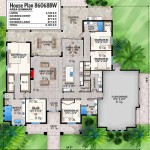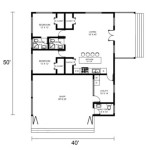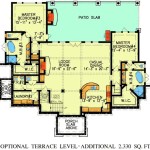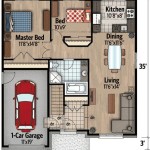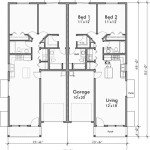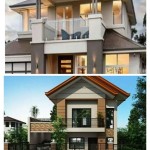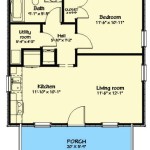House Plan Options: Exploring the One-Bedroom Home
The concept of a one-bedroom house plan often conjures images of compact living, ideal for singles, couples, or individuals seeking a minimalist lifestyle. However, the reality of one-bedroom house plans extends far beyond simple limitations. These designs can be incredibly versatile, offering a diverse range of layouts, styles, and functionalities tailored to specific needs and preferences. Choosing the right one-bedroom house plan requires careful consideration of personal lifestyle, budget, land availability, and future needs.
One-bedroom house plans are not inherently small or restrictive. Clever design and space optimization techniques can create a living environment that feels spacious, comfortable, and highly functional. The rise in popularity of smaller homes reflects a broader shift towards sustainable living, reduced financial burdens, and a desire for simplified lifestyles. This trend has fueled innovation in architectural design, resulting in one-bedroom plans that are both aesthetically pleasing and highly practical.
Evaluating a one-bedroom house plan involves examining numerous factors, including the overall square footage, room layout, storage solutions, natural light, and potential for future expansion. Additionally, understanding the implications of different architectural styles, building materials, and site conditions is crucial for making informed decisions. This article delves into various aspects of one-bedroom house plans, providing insights into key considerations and design options to help prospective homeowners navigate the selection process.
Maximizing Space and Functionality in a One-Bedroom Home
Efficient space utilization is paramount in a one-bedroom house plan. Every square foot needs to be carefully considered and optimized for maximum functionality. Open-concept layouts are a common strategy, combining the living room, dining area, and kitchen into a single, unified space. This approach creates a sense of spaciousness and allows for better flow of natural light throughout the home. However, careful planning is necessary to define distinct zones within the open area, creating a sense of order and preventing the space from feeling cluttered.
Strategic placement of furniture is crucial in maximizing space. Multi-functional furniture, such as sofa beds, storage ottomans, and folding tables, can significantly enhance the functionality of a room without compromising on space. Built-in storage solutions, such as bookshelves, cabinets, and closets, are also highly effective in minimizing clutter and maximizing usable floor space. Vertical storage, utilizing wall space from floor to ceiling, is another way to optimize space and keep belongings organized.
Natural light plays a significant role in making a small space feel larger and more inviting. Large windows, skylights, and strategically placed mirrors can help to reflect and distribute natural light throughout the home. Light-colored paint and flooring can also enhance the effect of natural light, creating a brighter and airier atmosphere. Artificial lighting should also be carefully considered, with a combination of ambient, task, and accent lighting used to create a well-lit and functional living environment.
The bedroom itself should be designed as a sanctuary, a peaceful and relaxing space that promotes rest and rejuvenation. Adequate storage space is essential, with closets, drawers, and under-bed storage providing ample room for clothing and personal belongings. The size of the bed should be appropriate for the room, allowing for comfortable movement and preventing the space from feeling cramped. A well-placed window can provide natural light and ventilation, while blackout curtains can ensure a restful night's sleep.
The bathroom should be designed for both functionality and comfort. A well-planned layout can maximize space and create a relaxing atmosphere. Consider a walk-in shower instead of a bathtub to save space, and opt for wall-mounted fixtures to create a sense of spaciousness. Adequate storage is essential for toiletries and personal items, with shelves, cabinets, and drawers providing ample room to keep the bathroom organized and clutter-free.
Exploring Different Architectural Styles for One-Bedroom Homes
One-bedroom house plans are not limited to a single architectural style. A wide range of styles can be adapted to suit the needs and preferences of the homeowner, each offering its own unique aesthetic and functionality. Understanding the characteristics of different architectural styles is crucial for selecting a plan that aligns with personal taste and lifestyle.
Modern architecture is characterized by clean lines, minimalist design, and a focus on functionality. Modern one-bedroom homes often feature open-concept layouts, large windows, and flat roofs. The emphasis is on creating a simple, uncluttered living environment that is both aesthetically pleasing and highly practical. Modern designs often incorporate sustainable materials and energy-efficient technologies.
Contemporary architecture is similar to modern architecture but incorporates more organic shapes and natural materials. Contemporary one-bedroom homes often feature asymmetrical designs, large windows, and open floor plans. The emphasis is on creating a living environment that is both comfortable and visually appealing, with a strong connection to the surrounding environment. Contemporary designs often incorporate eco-friendly features and technologies.
Traditional architecture encompasses a wide range of styles, including Colonial, Victorian, and Craftsman. Traditional one-bedroom homes often feature symmetrical designs, gabled roofs, and decorative details. The emphasis is on creating a classic and timeless living environment that reflects the architectural heritage of the region. Traditional designs often incorporate natural materials and handcrafted details.
Cottage-style architecture is characterized by its charming and cozy aesthetic. Cottage one-bedroom homes often feature small footprints, gabled roofs, and decorative details. The emphasis is on creating a warm and inviting living environment that feels like a retreat from the outside world. Cottage designs often incorporate natural materials and rustic details.
Choosing the right architectural style depends on personal preference, budget, and site conditions. It is important to consider the overall aesthetic of the neighborhood and select a style that complements the surrounding architecture. Consulting with an architect or designer can help homeowners navigate the complexities of different architectural styles and select a plan that meets their specific needs and preferences.
Key Considerations for Selecting a One-Bedroom House Plan
Selecting a one-bedroom house plan involves more than just choosing a layout and architectural style. Numerous factors need to be carefully considered to ensure that the plan meets the specific needs and preferences of the homeowner. Ignoring these factors can lead to dissatisfaction and costly modifications later on.
Budget is a crucial consideration. The cost of building a one-bedroom house can vary significantly depending on the size, materials, and location of the project. It is important to establish a realistic budget and stick to it throughout the planning and construction process. Obtain multiple quotes from contractors and suppliers to ensure that you are getting the best possible prices. Consider incorporating cost-effective materials and design features to reduce overall expenses.
Land availability and site conditions are also important factors. The size and shape of the lot will influence the type of house plan that can be accommodated. Site conditions, such as soil type, topography, and drainage, will also impact the construction process. A thorough site assessment should be conducted before selecting a house plan to ensure that the project is feasible and cost-effective.
Future needs should also be considered. While a one-bedroom house may be sufficient for current needs, it is important to think about potential future changes in lifestyle or family size. Consider selecting a plan that allows for future expansion or modification. This could involve adding a second bedroom, expanding the living area, or building a detached garage or workshop.
Local building codes and regulations must be adhered to. Building codes are designed to ensure the safety and structural integrity of buildings. Regulations may also govern aspects such as zoning, setbacks, and environmental protection. Consult with local authorities and obtain all necessary permits before starting construction. Failure to comply with building codes and regulations can result in fines, delays, and even demolition of the project.
Energy efficiency is another important consideration. Incorporating energy-efficient features into the design can significantly reduce utility bills and minimize the environmental impact of the home. Consider using energy-efficient windows, insulation, and appliances. Installing solar panels can also generate renewable energy and reduce reliance on fossil fuels. A well-insulated and energy-efficient home will be more comfortable to live in and cost less to operate.
Finally, consider the overall aesthetic and functionality of the house plan. The plan should reflect your personal style and meet your specific needs. Think about how you will use the space and how it will integrate with your lifestyle. Consult with an architect or designer to refine the plan and ensure that it meets all of your requirements. A well-designed and functional one-bedroom house can provide a comfortable and enjoyable living environment for many years to come.

Ranch Style House Plan 1 Beds Baths 896 Sq Ft 771 One Bedroom Plans

1 Bedroom House Plan Examples

3 Reasons To Build A 1 Bedroom House Plan

1 Bedroom Floor Plans Yahoo Search Results Small House Guest One

Contemporary House 1 Bedrm Bath 650 Sq Ft Plan 196 1211

30x24 House 1 Bedroom Bath 720 Sq Ft Floor Plan

Backyard One Bedroom Cottage House Plan 560000tcd Architectural Designs Plans

1 Bedroom Tiny House Plan

Best Small 1 Bedroom House Plans Floor With One

47 Flat 509 Sq Feet Or 35 M2 1 Bedroom House Plan


